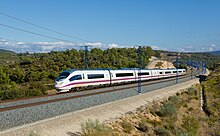Siemens Mobility
In the following years, inventions such as the first electric trolleybus, mine locomotives, and the first underground railway in continental Europe (in Budapest), set the path from trams and subways to today's high-speed trains.
[7] In July 2017, Siemens confirmed it had taken over Hannover-based software company HaCon, to be managed as a separate legal entity.
[8] In September 2017, Siemens announced a proposal to merge its transportation division with Alstom, with the objective of creating "a new European champion in the rail industry".
[9] The combined rail business, to be named Siemens Alstom and headquartered in Paris, would have had $18 billion U.S. in revenue and employed 62,300 people in more than 60 countries.
[12] During Innotrans in September 2018, Siemens Mobility unveiled the world's first driverless tram in Berlin, the result of a joint research and development project with ViP Verkehrsbetriebe Potsdam, on a six-kilometre section of the tram network in Potsdam, Germany.





